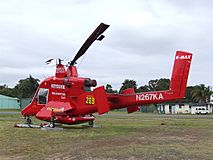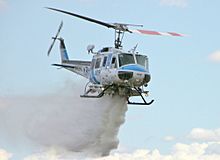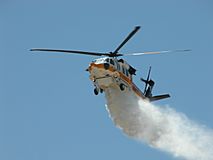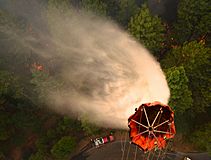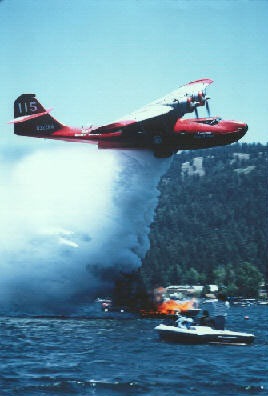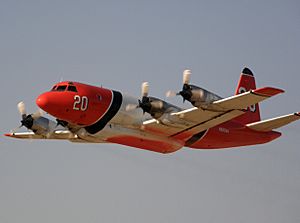Aerial firefighting facts for kids
Aerial firefighting, also known as waterbombing, is when special aircraft and other flying tools are used to fight wildfires. These aircraft include both airplanes (fixed-wing) and helicopters. Firefighters called Smokejumpers and rappellers also work from the air. Smokejumpers parachute from planes, and rappellers use ropes to get down from helicopters. To fight fires, these aerial teams use water, special foams or gels that help water work better, and fire retardants like Phos-Chek.
Contents
What are the names for it?
People use different names for aircraft that fight fires from the sky. In the United States, fixed-wing planes are often called airtankers or air tankers. In Canada, they might be called waterbombers, especially if they can land on water.
Air attack is a term for using these flying resources to fight a fire. It can also refer to the person in charge of all the aircraft fighting a fire from above. This person, often called "air attack" or the Air Tactical Group Supervisor (ATGS), flies above the other planes and helicopters. They make sure everyone works together safely to control the wildfire.
The "air attack" person helps decide how to respond to a fire. This could be the first response (initial attack) or managing a larger, ongoing fire (extended attack) that needs many resources like ground crews and more aircraft.
Equipment used
Many different helicopters and airplanes are used for aerial firefighting. The U.S. Forest Service and Bureau of Land Management use nearly 1,000 aircraft each fire season.
Helicopters
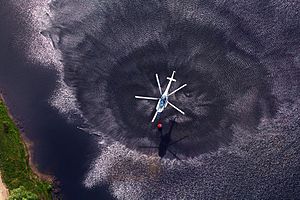
Helicopters can have tanks built into them (called helitankers) or carry large buckets underneath. Some helitankers, like the Erickson AirCrane, even have a foam cannon at the front. Helicopters usually fill their buckets by dipping them into lakes, rivers, or portable tanks. A popular type is the flexible Bambi bucket. Tanks on helicopters can be filled on the ground by trucks or by sucking water up through a hose while hovering over a water source.
Some common firefighting helicopters include the Bell 204, Bell 205, Bell 212, Boeing Vertol 107, Boeing Vertol 234, Sikorsky S-70 "Firehawk," and the Sikorsky S-64 Aircrane. The S-64 Aircrane has a special snorkel to fill its tank while hovering over water. The Mil Mi-26, one of the world's largest helicopters, uses a Bambi bucket.
-
A Kern County (California) Fire Department Bell 205 dropping water during a training exercise.
Water and fire retardant bombers
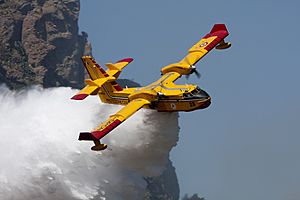
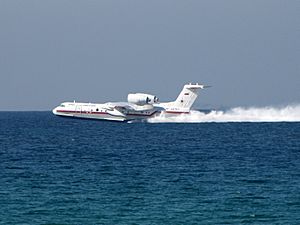
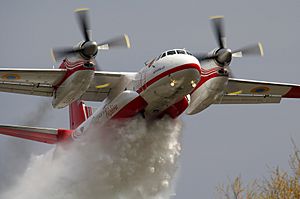
Airtankers or water bombers are airplanes with large tanks. They can fill these tanks on the ground at special bases. Some, like flying boats, can even scoop up water from lakes or rivers without landing.
Over the years, many different planes have been used for firefighting. At first, military planes were tried, even dropping water-filled bombs, but internal water tanks became the standard. Old bombers from World War II were used for a long time. Now, there are newer planes built specifically for this job.
The smallest airtankers are called Single Engine Air Tankers (SEATs). These are often agricultural planes that drop about 800 gallons (3,028 liters) of water or retardant. Examples include the Air Tractor AT-802 and the Soviet Antonov An-2. Some of these can even be fitted with floats to scoop water from lakes. The Canadair CL-215 and Canadair CL-415 are planes designed just for firefighting.
Medium-sized planes include modified aircraft like the Grumman S-2 Tracker and the Douglas DC-4. Larger planes like the Lockheed C-130 Hercules and Lockheed P-3 Orion are also used.
The biggest aerial firefighter ever used was the Global Supertanker, a modified Boeing 747. It could carry a massive 19,600 gallons (74,195 liters) of water or retardant! It has since been replaced by a Boeing 747-400. Another large jetliner used is the McDonnell Douglas DC-10-30, which can carry up to 12,000 US gallons (45,425 liters).
Russia uses Ilyushin Il-76 airtankers and Beriev Be-200 jet-powered amphibious planes. The Be-200 can scoop up about 12,000 liters (3,170 gallons) of water in just 14 seconds from a suitable body of water.
Newer airtankers are based on modern passenger planes like the Dash 8 Q Series and the British Aerospace 146. The McDonnell Douglas MD-87 and Boeing 737-300 have also been converted for firefighting. In 2022, Airbus even tested its large A400M military transport plane for firefighting by adding a huge water tank.
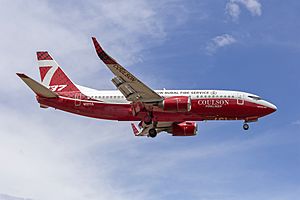
Comparison table of fixed-wing, firefighting tanker airplanes
| Make and model | Country of origin | Category | Water/retardant capacity, US gallons (litres) | Notes |
|---|---|---|---|---|
| Air Tractor AT-802F | United States | Light | 807 US gal (3,050 L) | |
| Air Tractor AT-1002 | United States | Medium | 1,000 US gal (3,800 L) | |
| AN-32P Firekiller | Ukraine | Medium | 2,113 US gal (8,000 L) | |
| BAe 146 | United Kingdom | Medium | 3,000 US gal (11,000 L) | |
| Beriev Be-200 | Russia | Medium | 3,173 US gal (12,010 L) | |
| Boeing 737-300 | United States | Medium | 4,000 US gal (15,000 L) | |
| Boeing 747 Supertanker | United States | Super heavy | 19,600 US gal (74,000 L) | |
| Bombardier Dash 8 Q400-MR | Canada | Medium | 2,600 US gal (9,800 L) | |
| Canadair CL-215 | Canada | Medium | 1,300 US gal (4,900 L) | |
| Canadair CL-415 | Canada | Medium | 1,621 US gal (6,140 L) | |
| Douglas B-26 | United States | Medium | No longer in service | |
| Douglas DC-4 | United States | Medium | No longer in service | |
| Douglas DC-6 | United States | Medium | 2,800 US gal (11,000 L) | |
| Douglas DC-7 | United States | Medium | 3,000 US gal (11,000 L) | |
| Fairchild C-119 Flying Boxcar | United States | Medium | No longer in service | |
| Grumman S-2 Tracker | United States | Medium | 1,200 US gal (4,500 L) | |
| Ilyushin Il-76 | Russia | Heavy | 11,419 US gal (43,230 L) | |
| Lockheed C-130 Hercules | United States | Medium | 3,000 US gal (11,000 L) | National Guard MAFFS units |
| Lockheed C-130Q Hercules | United States | Medium | 3,500 US gal (13,000 L) | Coulson RADS-XXL |
| Lockheed L-188 Electra | United States | Medium | 3,000 US gal (11,000 L) | |
| Martin Mars | United States | Medium | 7,200 US gal (27,000 L) | |
| McDonnell Douglas DC-10-30 | United States | Heavy | 12,000 US gal (45,000 L) | |
| McDonnell Douglas MD-87 | United States | Medium | 4,000 US gal (15,000 L) | |
| North American B-25 | United States | Medium | No longer in service | |
| P-2V Neptune | United States | Medium | 2,362 US gal (8,940 L) | |
| P-3 Orion | United States | Medium | 3,000 US gal (11,000 L) | military version of the Lockheed L-188 Electra |
| PBY Catalina | United States | Medium | 1,000 US gal (3,800 L) or 1,500 US gal (5,700 L) for the Super model | |
| PZL-Mielec M-18 Dromader | Poland | Light | 570 US gal (2,200 L) | |
| ShinMaywa US-2 | Japan | Medium | 3,595 US gal (13,610 L) |
Category legend: Light: under 1,000 US gallons (3,785 liters), Medium: under 10,000 US gallons (37,854 liters), Heavy: under 20,000 US gallons (75,708 liters), Super heavy: over 20,000 US gallons (75,708 liters) – currently only used for the B747 Supertanker.
Leadplanes
Leadplanes are smaller aircraft that fly ahead of the airtankers. Their job is to guide the airtankers to where they need to drop water or retardant. They describe the target and sometimes even fly the exact path for the airtankers to follow. In Canada, they are called "Bird Dog" aircraft. Common leadplanes include the Beechcraft King Air and the Twin Commander 690.
Fleet safety
Most aerial firefighting aircraft in the United States are owned by private companies and hired by government agencies. The National Guard and U.S. Marines also have firefighting planes.
In 2004, some older heavy airtankers were taken out of service by the U.S. Forest Service and Bureau of Land Management. This happened after two older planes crashed in 2002 due to serious metal fatigue in their wings. These events showed how important it is to keep aircraft safe. After careful checks and tests, new contracts were given to companies with a fleet of safer aircraft. Safety is always the top priority in aerial firefighting.
Fire retardant
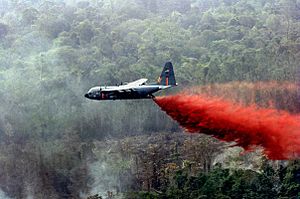
Fire retardants are special chemicals used to slow down or stop wildfires. In the past, some chemicals used were found to be harmful to soil and animals, so they are no longer allowed. Today, retardants are made with safer ingredients like ammonium sulfate or ammonium polyphosphate. They often have thickeners, wetting agents, and rust inhibitors. They are usually colored red so pilots can see where they have been dropped. Popular brands include Fortress and Phos-Chek.
Some water-dropping planes also carry a special gel that thickens the water. This helps the water stick to plants better and reduces how quickly it runs off.
Tactics and capabilities
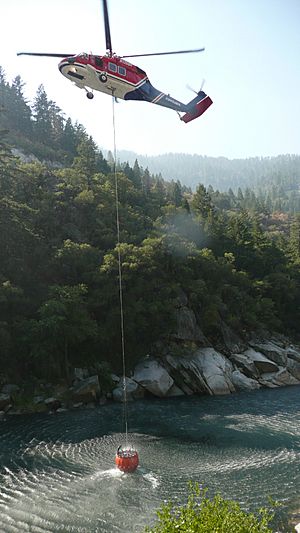
Helicopters can hover right over a fire to drop water or retardant. Some advanced helitankers have computer-controlled doors that adjust how they drop based on the area and wind. Airplanes, like bombers, fly in a straight line to release their load.
Spotter planes (Air Tactical Group Supervisors) fly higher up to coordinate all the aircraft and ground crews. Lead planes fly low, just in front of the airtankers, to show them exactly where to drop the retardant and ensure everyone's safety.
Water is usually not dropped directly onto flames because its effect doesn't last long. Fire retardants are also not typically used to put out the fire itself. Instead, they are dropped in front of or around a moving fire. This creates a "firebreak" that helps contain the fire or slow it down, giving ground crews time to get there and control it.
Aerial firefighting works best when it's combined with efforts from firefighters on the ground. Aircraft are just one important tool. However, sometimes aircraft can put out fires before ground crews even arrive.
Some firefighting aircraft, like the Bombardier CL-415, can refill their tanks while flying. They do this by skimming the surface of large lakes or rivers. This is very helpful in remote areas where flying back to an airbase to refill would take too much time. For example, one CL-415 crew refilled 100 times in a 4-hour mission, dropping a huge amount of water on a fire in Ontario, Canada.
Accidents and incidents
Aerial firefighting is a dangerous job, and sadly, accidents can happen. Over the years, there have been crashes involving both airplanes and helicopters, sometimes resulting in the loss of pilots and crew members. These incidents, while tragic, have led to important safety improvements and stricter checks on aircraft to ensure the safety of those fighting wildfires from the sky.
See also
 In Spanish: Lucha aérea contra el fuego para niños
In Spanish: Lucha aérea contra el fuego para niños
- Glossary of wildfire terms
- Smokejumper
- Wildfire suppression
- Modular Airborne FireFighting System
- Aerial firefighting and forestry in southern Australia
Images for kids
-
A Neptune Aviation Lockheed P2V drops flame retardant at Pine Mountain, Oregon. (2014)


